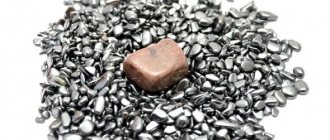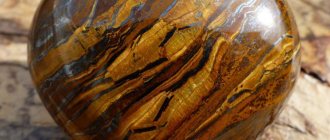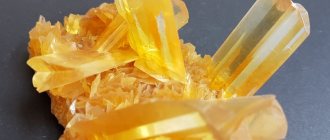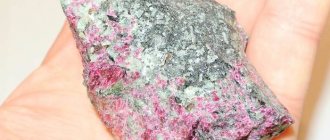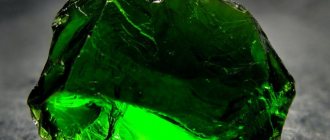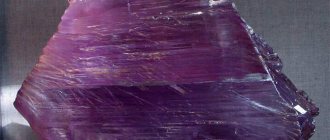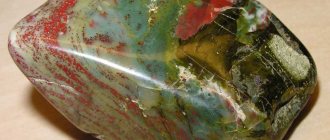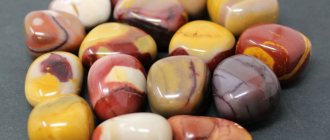/ List of stones / Characteristics and properties of Spessartine stone
0
2869
Article rating
A crystal whose bright orange color resembles the element of fire. A mineral whose composition and number of carats delights many jewelers around the world. Spessartine stone is rare, which is why it is highly valued by magicians, lithotherapists and ordinary jewelry lovers. Spessartine is a variety of garnet that was first discovered in Bavaria. Its rich red color is due to the content of manganese and aluminum particles.
Properties of Spessartine stone
Physical and chemical properties
In terms of its chemical composition, spessartine is a manganese aluminosilicate, which in the composition of the mineral is often replaced by iron and magnesium. The impurities usually include titanium, calcium, yttrium, iron, magnesium, and water.
Spessartine has the following physical characteristics:
- hardness up to 7.5 on the Mohs scale;
- density – up to 4.32 g/cm³;
- greasy glass shine;
- full transparency, translucency and absolute opacity;
- line color – white;
- imperfect cleavage;
- conchoidal, uneven fracture;
- form in the form of interspersed grains, well-formed druses and crystals;
- vulnerable to high temperatures;
- refractive index – 1.8;
- There is no fluorescence or magnetism effect.
Spessartine crystals are in most cases small in size. Despite its high strength, the mineral is very fragile and has a tendency to crack.
Spessartine stone – properties, color, deposits
Spessartine belongs to the garnet group, but is very rare. If you have not yet heard of garnets, then you may be interested to know that in the Middle Ages, any red-colored stones were called garnets, and the word itself comes from the association of these gems with the grains of the pomegranate tree.
The entire garnet group of minerals is silicates of elements such as iron, magnesium, manganese, chromium, calcium. There are more than 20 varieties of these crystals, but spessartine is one of the most noticeable, beautiful and expensive in this series. Let's get to know him better.
History of the stone
It is not known for certain when the first spessartine was found, but in 1797 it was mentioned as “garnet ore” mined in the Bavarian mountains. In 1823, the stone was discovered in the United States and designated as “manganese garnet.” The modern name “spessartine” was proposed by the mineralogist François Beudan in 1832 in honor of the deposit among the Spessart mountains in Bavaria.
Garnets entered the world jewelry market only in the early 90s of the last century after the discovery of a new deposit in Namibia, and in 1999 another one was found, now in Nigeria. But by the early 2000s, all reserves of spessartine began to deplete, which provoked a sharp rise in prices for this orange gem. We will talk in more detail about spessartine prices at the end of the article.
Physical properties
Formula: Mn3Al2[SiO4]3
Mohs hardness: 6,5-7,5
Color: red-orange, orange-yellow, pink, red, yellow-brown
Refractive index: 1,80
Gloss: glass
Cleavage: imperfect
Fracture: uneven, conchoidal
Density: 3.8 - 4.3 g/cm³
The fairly high density and hardness of spessartine makes it easy to process for jewelry: the stone does not crack, does not crumble, and lends itself well to cutting.
The highly transparent structure of this gem allows it to glow and shine with a fiery light similar to the sun, which is especially noticeable after the stone is cut. Many people notice that the glow of spessartine seems to come from within, but a constant stream of external daylight can damage the stone, as it becomes more susceptible to cracking and tarnishing.
Place of Birth
Spessartine is a fairly rare stone, although it can be found in many countries. But what is especially interesting is that any of the orange crystals found will bear the imprint of its deposit. In other words, it is difficult to confuse a specimen from Tanzania with a nugget from America.
Let us list the main places where spessartine is mined and the color that is characteristic of stones coming from these places.
Africa - bright orange specimens with a red undertone are found here. The main mining sites are concentrated in Tanzania, Mozambique, Namibia and Nigeria.
Madagascar - the island contains specimens of unusually thick color with a very bright shine.
Asia - The best quality spessartines are found in Afghanistan and Pakistan; these stones are characterized by a dark red color. Indian gems have a cherry color, while Chinese ones contain admixtures of smoky quartz.
Europe - spessartines in an orange palette are found in Russia, Italy, Norway, and in the Alpine mountains.
America - yellow-orange large stones are supplied to the world jewelry market from the central and northern parts of the continent.
Australia - Large nuggets have a scarlet and/or purple sheen.
Primary colors of spessartine
There are 4 main varieties of spessartine depending on the color. Surprisingly, there is no refining technology for this stone, so every spessartine before your eyes will appear absolutely natural, with a pure natural shade. However, these gems weighing up to 10 carats almost always contain many inclusions, so it is quite rare to find a completely transparent specimen.
So, the main shades of spessartine:
Mandarin or Fanta
Fiery orange
Orange
Red-orange
Mythology and magical properties of spessartine
Garnets, which include spessartine, have been known to mankind for many centuries, so they are shrouded in many legends and myths. For example, many people think that Noah used a red garnet to light his way on the Ark. It is also known that garnet was a favorite stone for travelers, as it supposedly could illuminate their path and save them from the machinations of evil spirits.
The orange and red colors that characterize garnets and spessartines in particular have many meanings in religions and cultures. In Christianity, the color red symbolizes the blood and sacrifice of Christ, and among Asian peoples, orange has a special relationship - Buddhist monks wear clothes of this color and the Buddha himself is depicted in an orange robe.
Magicians and sorcerers are sure that spessartine brings happiness to those who are used to leading a tense and emotional life. But he can cause trouble for cold and calculating people if they do not know how to listen to their hearts. Lithotherapists believe that spessartine is recommended for people who have problems with the cardiovascular system, blood diseases or disorders of the spine. The gem also helps fight allergies and promotes the body's absorption of calcium and magnesium, which are vital elements.
Who is suitable for jewelry with spessartine?
Spessartine jewelry is ideal for almost every occasion. Products with large stones are suitable for business events or for a dinner party, and with small stones - for everyday outings or walks. In other words, spessartine will become a universal stone in your jewelry box.
Spessartine is believed to serve as a talisman for people born between the end of July and the end of September. It will bring such owners success in business and give them the strength to achieve their goals. If you were born at the end of September - October, then spessartine will give your character such traits as courage, will, and dedication. The gem will become a love mascot for those born between October 22 and November 20; esotericists explain this by the red hue of the stone, which is responsible for passionate feelings.
Spessartine in jewelry
Spessartine is actively used in jewelry as a material for the manufacture of all types of jewelry: rings, earrings, bracelets, necklaces, pendants and others. This stone is bought by collectors, professional jewelers and “hand made” craftsmen.
The Smithsonian Institution in the United States features three remarkable and one-of-a-kind red-orange spessartines: 109 and 54 carats from Brazil and 30 carats from Madagascar.
Famous jewelry companies, for example, Cartier, Dior, Hemmerle, admire the beauty of spessartine.
One of the largest collections of jewelry with orange stone belongs to Maxim Demidov.
How to care for stone
As part of jewelry, spessartine looks both impressive and elegant, which encourages you to wear it almost every day, so products with an orange gem require special care and careful handling.
First of all, you should not wear jewelry with spessartine to the beach, when going to the pool or to a body of water. Sunlight will gradually destroy the rich color of the stone, and water, and especially sand, will damage both the product in general and the stone in particular.
Chemicals, detergents, cosmetics - all this should be kept away from crystals of colored stones, spessartine is no exception in this case. It regularly requires wiping with a special cloth, which removes grease and dirt that impede the breathtaking brilliance of the faceted nugget. The stone must also be stored carefully: avoid contact with other stones and exposure to temperature changes.
For general rules for caring for jewelry with gems, read our article Caring for jewelry with gems.
Price
Rare types of pomegranate are quite expensive. These include tsavorites, demantoids and, of course, spessartines. In 1980, red-brown specimens cost up to $35 per carat, and orange ones weighing from 1 to 4 carats cost up to $100 per carat. Today, spessartines sell for much more and continue to rise in value, making them a worthwhile investment.
Prices for stones are set according to their abundance, quality and size, color and clarity. Bright orange spessartines are the rarest and most sought after, so they can be valued at up to $10,000 carats.
Specimens larger than 10 carats are especially valued; their value is determined individually depending on their aesthetic properties. There is no exact price list for spessartines, but every year they become more and more expensive, since large stones with a minimum number of inclusions are extremely rare.
In the Maxim Demidov catalog you will find spessartine jewelry of exceptional quality.
Colors and varieties
Spessartine is classified by color and variety depending on the predominant impurities in the composition.
The main colors of the mineral are distinguished:
- pale orange - “fanta”;
- bright orange is the rarest and most valuable type of stone;
- dark orange – “tangerine”;
- red-orange;
- red - valued on a par with bright orange gems.
Depending on the impurity in the composition, spessartine is divided into varieties:
- Emildine - contains a high percentage of yttrium in its composition, the first samples were discovered in Namibia.
- Brandaosite differs from other varieties in its small proportion of iron and aluminum. Brandaosite is mined in Portugal.
- Spandite are samples of spessartine in which iron and calcium or aluminum and magnesium predominate as impurities.
- Calcium Aisenspessartine - stones that contain large amounts of iron and calcium.
- Johnstonotite is a dark red mineral containing calcium with a large number of other visible impurities.
In mineralogy, spessartine can be found under many other names - cashmirine, parthinite, erinite, tangerine garnet, spessartine garnet.
History of origin and place of extraction of spessartine
The gem received its name “spessartine” from the mountainous area in Germany in which it was first discovered - the Spessart plateau in the region of Bavaria.
The French geologist Francois Sulpice Beudan gave the mineral this name in 1832; previously it was called differently - tangerine garnet, carbuncle (classified as rubies). There are also varieties of spessartine, which differ in place of origin, shade and composition:
- Brandaosite - has low aluminum and iron content, found in Portugal;
- Johnstonotite is a brown-red calcium spessartite with impurities;
- Calcium Aisenspessartin - contains a lot of calcium and iron;
- Spandite - has a high content of calcium with iron, or magnesium with aluminum;
- Emildine - contains yttrium metal, mined in Namibia;
Other synonyms: erinite, kashimirin, tangerine stone, parcinite, manganese aluminosilicate.
Photo: Petr Fuchs, flickr.com
Photo: Igor3, photosight.ru
Photo: Petr Fuchs, flickr.com
Production
Earlier in the 1990s, the main places where spessartine was mined (according to the book “Stones: Mysticism and Reality” by F. K. Velichko, p. 350): were in Russia, the USA, Brazil, Germany, Mozambique, Madagascar, Sri Lanka, Sweden. The stones were rare, only narrow specialists and collectors were familiar with them.
Since 1991, significant deposits of tangerine garnet were discovered in African countries, after which new jewelry began to be sold on world markets, winning the hearts of connoisseurs of beautiful stones.
Spessartine, suitable for creating jewelry, is also mined during mining in Russia, the USA, Mexico, Myanmar, Italy, Sweden, China, Pakistan, Nigeria, Namibia, Norway, Tanzania and Sri Lanka. Cherry-colored minerals are found in India.
The rarest specimens weighing more than 100 carats (about 5 cm) were found in the Urals, Transbaikalia and Karelia, and abroad: in Mozambique, Brazil, and Madagascar.
The mineral is found in the form of cloudy crystals with cracks and inclusions, in the form of druses, crystalline crusts, inclusions, veins and granular masses. Spessartine is found in metamorphic rocks, in the skarn rock with a high manganese content. Manganese garnet is found with associated minerals: quartz, magnetite, muscovite, kyanite, biotite, sillimanite, rutile and actinolite.
Pure transparent crystals of spessartine of small size are found in the rare-metal pegmatite rock.
Photo: Stan Celestian, flickr.com
Photo: Stan Celestian, flickr.com
Garnet, Stan Celestian, flickr.com
Mineral deposits
Deposits of spessartine can be found in many parts of the planet, with each deposit producing rock of a certain shade. For example:
- Red-orange bright gems are mined in African countries - Tanzania, Mozambique, Nigeria, Namibia.
- Deposits of large-sized yellow-orange crystals are developed in areas of Central and North America. Brazil is famous for stones that have the alexandrite effect.
- Premium dark red crystals are supplied by Asian countries - Afghanistan and Pakistan. In China, small gemstones with inclusions of smoky quartz are mined.
- Cherry-colored spessartines are mined in India.
In Europe, the main deposits are located in the Alps, Italy and Norway.
Russia is developing spessartine deposits in the Urals and Transbaikalia.
History and deposits
Spessartine is a mineral from the garnet group. It is rare and therefore worth a lot of money. This type of garnet was discovered relatively recently - in the middle of the 19th century. The discovery was accidental, but soon the gem began to be found in other regions.
The first to notice the unknown stone was Prague professor Francois Beudan. The scientist saw it while traveling in Bavaria, and then described it in his work “Traite Elementaire de Mineralogie”.
Largest supplying countries:
- Brazil;
- Australia;
- Tanzania;
- Nigeria;
- China.
Crystals are mined in the USA, Sri Lanka, and Madagascar. Spessartine is also found in Russia. It was found in the foothills of the Middle Urals, as well as in the rocks of Karelia.
The magical properties of spessartine
The magical properties of tangerine pomegranate are multifaceted. First of all, spessartine is a powerful protector from troubles, misfortunes, damage, envy and other machinations of ill-wishers.
The mineral has a beneficial effect on the spiritual state and charges with positive energy. It lifts your spirits and drives away bad thoughts.
Spessartine also affects human thinking. It sharpens intuition and logic, promotes the development of creativity. The effect of the mineral is enhanced by combination with yellow and blue stones.
The properties of spessartine have also been noticed in the love sphere. The stone ignites passion, enhances attraction to a partner, bewitches and attracts two hearts in love.
Practicing clairvoyants and magicians use the power of spessartine to communicate with the other world and decipher the signs of fate.
Therapeutic properties of the stone
Lithotherapists today talk a lot about the beneficial effects of the energy of gems on the human body. Several centuries ago, healers also actively used the power of stones in their practices. Lithotherapists highlight the main therapeutic properties of spessartine:
- the energy of the stone helps improve digestion, stabilize the condition of the spleen and pancreas;
- wearing a pendant with a precious stone helps get rid of urological diseases;
- a ring with a stone will relieve men from impotence, and will help women endure childbirth more easily;
- wearing a short necklace inlaid with stones relieves sore throat and helps normalize breathing;
- the energy of the mineral helps get rid of migraines and headaches;
- the stone helps hypotensive patients normalize blood pressure levels;
- the gem has the ability to stop minor bleeding.
Experts say that constant contact with spessartine helps a person get rid of the disease faster and regain good spirits. Any decoration with a mineral will strengthen the immune system and maintain vitality.
Spessartine also helps reduce the tendency to allergic reactions. Thanks to its energy, calcium and magnesium are absorbed in the body. Women should definitely buy themselves a pendant or necklace with a precious stone, it will improve the condition of their skin.
People prone to depression need to please themselves with a precious gift. The power of spessartine will help you become more stress-resistant and get rid of depression.
Talismans, amulets
Spessartine is credited with masculine energy, so it can only be used as a talisman or amulet by people with qualities such as willpower, assertiveness and self-confidence.
A spessartine amulet is necessary for people whose profession involves quick response, danger and life risks. These are rescuers, athletes, racing drivers, stuntmen.
A talisman with a stone helps businessmen. The energy of spessartine is used to expand business and increase profits due to this. The stone will highlight the leaders of large companies as leaders in the team.
Red spessartine is rightly called the amulet of love. It is believed that it enhances the attractiveness and attractiveness of its owner, captivating the views of the opposite sex.
Impact on different areas of activity
Spessartine will be an excellent amulet for athletes and people associated with risk. The pomegranate will protect against dangerous injuries and reduce the number of risky situations.
For managers of large projects or a larger number of subordinates, the stone will help achieve the most effective planning and personnel management. They will begin to take into account the wishes and interests of employees, find effective ways to motivate, and distribute responsibilities correctly.
For those who have their own business, the stone will help improve their current condition and increase profits. You can expect success in any endeavor. If you wear a bracelet or ring with spessartine every day, then power and control over colleagues will have a positive impact on the company's activities.
Medicinal properties
Spessartine has a beneficial effect on the body's vital systems. As an adjuvant against the background of the main treatment, it is used for:
- treatment of the cardiovascular system;
- normalization of blood pressure;
- pain relief;
- eliminating problems with digestion of food;
- relieving inflammatory processes, speeding wound healing;
- treatment of skin diseases;
- normalization of the genitourinary system;
- treatment of diseases of the blood, liver and spleen.
This mineral has a beneficial effect on the immune system and improves the body's protective functions.
Spessartine is also used for nervous disorders and stressful situations. The stone gives peace, a feeling of security and spiritual harmony, lifts your spirits, and inspires optimism.
Spessartine and Zodiac
Since spessartine does not have a long and established astrological “biography”, various schools of astrologers correlate it with different signs of the Zodiac.
Here is one of the versions of horoscope compilers: spessartine extends its protection to those born under the constellations of Scorpio, Aquarius and Sagittarius. This is a stone of positive energy and love.
Other astrologers claim that spessartine stone favors the zodiac signs Pisces, Libra and Cancer. Some astrologers consider spessartine an extremely dangerous crystal, under the influence of the gloomy Pluto and capable of bringing trouble to the owner. These horoscope interpreters recommend staying away from him, especially Virgos and Capricorns.
Areas of application
Jewelry craftsmanship is the main area of application of spessartine. Despite its fragility and difficulty in processing, the stone is in great demand both among handmade craftsmen and large jewelry brands.
All types of jewelry are made from the mineral; jewelry inserts are professionally cut. Framed with spessartine in silver or gold.
The price of spessartine depends on several factors - color, degree of transparency, deposit and size of the stone. Bright orange gems are valued more than all other varieties of the mineral. Faceted spessartine crystals weighing over 5 carats also cost several thousand dollars.
On the stone market you can find more affordable specimens. Usually these are small stones of low quality. Their price varies between $15-90 per copy.
Spessartine is no less in demand among collectors who are not averse to purchasing agglomerates of unusual shapes, as well as samples of stone fused with other rocks.
History of spessartine
Spessartine is a type of garnet. It is known as a rare manganese-aluminum stone. Despite its rarity, it is very popular and in demand on the jewelry market and among collectors, and has excellent jewelry qualities.
The stone was named spessartine after the place where it was first discovered - in the Spessart mountains. The term was introduced in the early 19th century by the mineralogist Bedan. In addition, spessartine is also found under such synonyms as tangerine stone, garnet, spessartite.
How to distinguish an original from a fake
It is easy for an uninformed buyer to confuse processed spessartine with other natural but cheaper minerals. Visually, this orange gem is practically indistinguishable from zircon and tourmaline.
However, unscrupulous sellers offer not only minerals of natural origin, but also artificial materials as counterfeits of spessartine. It is quite simple to distinguish them from natural stone:
- glass and plastic are much lighter than real stone;
- it is much easier to heat an artificial fake in your hand than a natural mineral;
- real spessartine cannot be scratched with a needle, but it leaves a mark on the glass in the form of a white line;
- There should be no sharp changes in color in the texture of a natural mineral; shades smoothly transition from one to another.
It is better to purchase an expensive product with spessartine with an experienced gemologist or jeweler in a trusted store.
Areas of use of spessartine
Jewelry brands actively use beautiful minerals. Craftsmen like to create original jewelry with stones of unusual colors. Gems are no less popular among handmade lovers. Even at home you can create a beautiful necklace or pendant from spessartine.
Jewelers prefer to frame bright edges in silver and gold. The shine of the noble metal perfectly sets off the beauty of the mineral. Thanks to professional cutting, the stone shines and literally emits a bright light.
How to care for stone
When storing tangerine pomegranate, it is enough to follow only a few basic rules:
- protect the mineral from the sun, otherwise it may fade and crack;
- avoid sharp impacts, squeezing and falling of the stone, since, despite its high hardness, the mineral is very fragile and prone to cracking;
- Wash spessartine several times a month with soapy water and warm water, then immediately dry it with a cloth.
Spessartine is stored separately from other, more fragile stones to avoid damage. To do this, use a separate box, soft case or velvety bag.
Production (field)
Spessartine is mined from igneous, metamorphic and pegmatite rocks.
A large number of stones were discovered at the beginning of the 21st century in Tanzania near the Serengeti National Park. Specimens from this deposit were first introduced to the market in 2008. Previously, large orange stones were supplied from Namibian deposits, but their quantity has now decreased. Another area with spessartine deposits is located on the Jos Plateau, Nigeria. Under the trade name Malaya Garnets, stones native to the Umba River Valley, Tanzania are known.
In the late 1990s, another mineral deposit was discovered in Zhangzhou Prefecture, China. Stones from this region are small gems containing smoky quartz. The finest quality dark red spessartine found alongside contrasting white albite comes from Pakistan. Gems of similar quality have also been found in Afghanistan.
Stones with a glassy sheen, sometimes with deep grooves, are mined from several mines in Brazil. Several other deposits are located in South Wales, Australia; Sondrio, Italy; Elba Island, Italy and Austria-Agder, Norway.
In the US, the most famous deposits of the mineral are located in California, Colorado, New Mexico and Utah.
In natural conditions, stones are found next to quartz, albite, microcline, orthoclase, muscovite, schorl (black tourmaline), topaz, riebeckite (a subtype of asbestos), magnetite and rhodonite.
Interesting facts and legends
There are also interesting facts in the history of spessartine stone. One day, all visitors to the Christie's auction were amazed by the sight of a platinum ring with a delicate tangerine-colored parthin that weighed 15 carats. The sale of such jewelry became a record in the jewelry industry.
And the Smithsonian Research Institute, located in the United States, has samples of Brazilian orange garnets weighing 54 and 109 carats. The American History Museum holds a specimen of a tangerine gem weighing about 97 carats. And the London Geology Museum has a crystal weighing more than 12 carats.
Spessartine garnet is a very positive gem. Its beautiful appearance has a beneficial effect on the owner. And if a person believes in the power and strength of the amulet, then the stone will become a real protector of a person.
Originally posted 2018-05-18 22:44:11.
What stones are similar to spessartine?
Experts identify several gems that are similar in appearance to erinite. This:
- Andradite. It is a variety of garnet and cannot be distinguished from spessartine with the naked eye.
- Grossular. It is a variety of the pomegranate group and is found in the color scheme of gooseberries throughout the entire period of its ripening. Without special equipment, it will not be possible to distinguish the mineral from spessartine.
- Pyrope. It is a representative of the pomegranate class. This mineral is characterized by a rich and very bright color scheme. In nature, you can find deposits with transparent and translucent samples. Only a specialist can see the difference between transparent pyrope and spessartine.
It is rare to come across a counterfeit on the market when, instead of expensive spessartine, they offer a synthetic analogue of oolongite. But experts still recommend buying jewelry in jewelry stores, whose owners value their reputation and check the stones for their authenticity.
Applications and stone products
The rarest nuggets are kept in famous museums around the world and private collections. Exhibited at exhibitions of world significance. Jewelers pay special attention to the gemstone, making earrings, beads, bracelets, rings, pendants, and pendants based on it.
The price of such jewelry per carat is very high, so the stone is placed in a frame made of gold, rarely silver. Dark orange samples are especially valuable in jewelry. Uncut copies are used by lithotherapists and magicians.
Compatibility with Zodiac signs
Many astrologers agree that the mineral is suitable for:
- Leos, Aries and Sagittarius (strengthens leadership positions, helps control emotions).
- Cancers, Aquarius, Pisces and Scorpios (ensures the development of creative abilities, increases self-esteem, fuels energy).
Virgos, Capricorns and Taurus should not use the stone, as it will cause financial losses and cause problems on an emotional level.
In cases where you want to buy jewelry with spessartine minerals, but astrology does not advise according to your zodiac sign, experts recommend holding the gemstone in your hand and listening to your own feelings. If the mineral does not cause discomfort, then it can be worn in jewelry.


